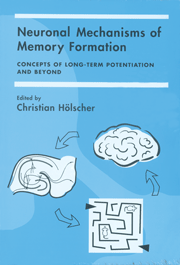Book contents
- Frontmatter
- Contents
- Contributors
- Introduction: Long-Term Potentiation as a Model for Memory Mechanisms: The Story So Far
- Section One Long-Term Potentiation In Vitro and In Vivo: How Can We Fine-Tune the Current Models for Memory Formation?
- Section Two There is More to the Picture Than Long-Term Potentiation: Theta or Gamma Oscillations in the Brain and the Facilitation of Synaptic Plasticity
- Section Three Making Models from Empirical Data of Synaptic Plasticity
- Section Four Setting the Stage for Memory Formation: Stress, Arousal, and Attention
- 13 Strategies for Studying the Role of LTP in Spatial Learning: What Do We Know? Where Should We Go?
- 14 What Studies in Old Rats Tell Us about the Role of LTP in Learning and Memory
- 15 Implications of the Neuropsychology of Anxiety for the Functional Role of LTP in the Hippocampus
- 16 Differential Effects of Stress on Hippocampal and Amygdaloid LTP: Insight Into the Neurobiology of Traumatic Memories
- Section Five Transgenic Mice as Tools to Unravel the Mechanisms of Memory Formation
- Conclusions and Future Targets
- Index
13 - Strategies for Studying the Role of LTP in Spatial Learning: What Do We Know? Where Should We Go?
Published online by Cambridge University Press: 13 October 2009
- Frontmatter
- Contents
- Contributors
- Introduction: Long-Term Potentiation as a Model for Memory Mechanisms: The Story So Far
- Section One Long-Term Potentiation In Vitro and In Vivo: How Can We Fine-Tune the Current Models for Memory Formation?
- Section Two There is More to the Picture Than Long-Term Potentiation: Theta or Gamma Oscillations in the Brain and the Facilitation of Synaptic Plasticity
- Section Three Making Models from Empirical Data of Synaptic Plasticity
- Section Four Setting the Stage for Memory Formation: Stress, Arousal, and Attention
- 13 Strategies for Studying the Role of LTP in Spatial Learning: What Do We Know? Where Should We Go?
- 14 What Studies in Old Rats Tell Us about the Role of LTP in Learning and Memory
- 15 Implications of the Neuropsychology of Anxiety for the Functional Role of LTP in the Hippocampus
- 16 Differential Effects of Stress on Hippocampal and Amygdaloid LTP: Insight Into the Neurobiology of Traumatic Memories
- Section Five Transgenic Mice as Tools to Unravel the Mechanisms of Memory Formation
- Conclusions and Future Targets
- Index
Summary
SUMMARY
Recent data from research on spatial learning mechanisms with the water maze are discussed, with emphasis on the role of NMDA receptor-dependent long-term potentiation (LTP). Detailed analysis of behavior in the water maze has indicated a need to distinguish among different components of this seemingly simple task. Nonspatial pretraining allows for the separation of behavioral strategy learning and learning the spatial location of the hidden platform. Nonspatially pretrained rats can learn the location of a hidden platform as quickly as controls despite being treated with any of a variety of pharmacologic agents. When a water maze task of conventional difficulty is used, nonspatially pretrained rats given an NMDA receptor antagonist to block hippocampal LTP can learn the location of the hidden platform as quickly as controls. When an especially difficult water maze task is used, involving repeated one-trial learning with repeated reversal learning, blockade of hippocampal LTP produces a spatial memory impairment for long but not short retention intervals in nonspatially pretrained rats. These and other experiments point to an important issue of task difficulty in the research. It should prove useful to systematically vary experimental treatments and task difficulty as a means of identifying specific brain circuits that are important for specific components of the water maze or other tasks. This information can then be used to further evaluate the role of LTP in the learning.
Introduction
Long-term potentiation (LTP) has properties of central nervous system change that are inherently interesting and that could be relevant to a variety of behavioral phenomena. Chief among these is its relevance to systematic and enduring behavioral change, or learning and memory.
- Type
- Chapter
- Information
- Neuronal Mechanisms of Memory FormationConcepts of Long-term Potentiation and Beyond, pp. 327 - 345Publisher: Cambridge University PressPrint publication year: 2000



